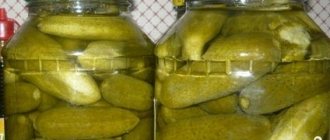- Posted by Svetlana Grishkina
- Date: September 28, 2018
Screw-on canning jars have become very popular these days. They are very convenient, easy to use, and save time and effort compared to seaming machines. But here’s the problem: screwing such a jar is as easy as shelling pears, but opening it is often very difficult. Why this happens and how to cope with such a nuisance - we’ll talk about this in today’s article.
- 2 How to easily deal with a twist-off lid
2.1 Photo gallery: helpers in opening screw-on glass jars
Why don't they open?
Reusable twist-off screw lids for canning are very convenient. The principle of their operation is quite simple: when heated with hot water or steam, the polymer coating on the inside of the lid becomes softer, due to which the jar closes tightly. After this, the lid begins to cool, its top retracts, creating a vacuum effect. In this case, a strip of polymer acts as a sealing gasket.
Glass jars with screw-on lids are the most popular today for storing a variety of pickles and preserves.
To reuse the cap, you need to unscrew it carefully. To do this, you can use a special key or open the jar with your hands very carefully, if, of course, you have enough strength. But more often than not, it is precisely these strengths that the hostess lacks, and a strong, muscular man is not always nearby. The reasons why the jar is difficult to open may be the following:
- slippery hands or jar surface;
- the lid fits tightly to the neck of the jar, simply sticking to it; this problem usually happens with jars of honey or jam;
- The pressure in the jar is below atmospheric, causing the lid to retract more than necessary.
Note! It is very important to know correctly which way to turn the lid. It closes clockwise and unscrews in the opposite direction.
Before you start unscrewing the lid, take a closer look at the entire jar: maybe you shouldn’t open it to serve the contents? If the lid is swollen, it means that the canned food has already spoiled. When unscrewed, the lid may even fly off the jar and hit you in the face, followed by the entire contents.
If you find a crack on the surface of the jar, then you should not open it either. Air may have gotten inside, spoiling the food; even worse - micro-shards of glass.
Methods of influencing cans
Contrary to popular belief, the easiest way is to open a tin can. There is no need to try to flatten it between two stones or heat it in a fire (oven), hoping that the metal will become more pliable. It is better to use one of the following approaches:
- Using a spoon. We place the container on a dense, stable surface, hold it with one hand, and take a metal spoon in the other (plastic, aluminum, wood and other fragile materials will not work). Place the tip of the rounded part of the spoon as close as possible to the rim, which is on every tin can. The spoon should be positioned so that its convex part is outside the jar, and not turned towards its center. Pressing the instrument, we begin to move it back and forth, as if swinging. We continue until we can completely wipe the thin metal of the lid. Next, we move the spoon and repeat our actions, “cutting out” a new hole in the lid. We continue to work in this way until a line is formed that allows us to open the container.
- Using a chef's knife. In this case, you need to place the jar on a flat and stable surface at approximately waist level. It is strictly forbidden to try to squeeze the container between your legs, as this can seriously cut you. The knife blade must be heavy, otherwise nothing will work. We take the tool by the part where the blade is attached to the handle, and place the base of the blade (opposite the tip) on a tin can, as close as possible to the side. We begin to put pressure on the device, trying to pierce the metal. After the hole is made, we move to a new area located as close as possible to the first. We work like this around the entire circumference of the lid until we can open it.
We recommend: What to eat for the New Year: delicious options for the celebration
Tip: Everyone knows that before opening the container, it must be thoroughly wiped with a slightly damp cloth to clean it. Then it is recommended to treat the lid until completely dry. If moisture remains on the metal surface, the tool may slip, causing injury.
- Using a pocket knife. We take the knife in one hand, place it vertically on the lid of the jar, and with the other hand we hit the hand with which we hold the handle several times. We don't hit it too hard, we just need to make a hole. We make such holes around the circumference, placing them as close to each other as possible. After this, all that remains is to lift the lid with the tip of a knife and open the container.
- Using a stone or a piece of concrete. The most primitive, but quite effective method. We select a rough stone, press the jar on top of it, and begin to rub with slight pressure, moving around the perimeter. We do this until liquid from the container drips onto the stone, this will mean that the metal has been sufficiently rubbed. We immediately turn the product over, hook the lid with a knife or something sharp and try to open it. Considering that the material will be thinned, this should not cause problems.
It is strictly forbidden to simply try to saw through a tin can with a knife. This will ruin its tip, and metal shavings will definitely get into the food. It is better to make precise punctures. The approach will take a little longer, but it is safer and more practical.
How to easily deal with a screw cap
Most often, such jars open without much difficulty, but sometimes, no matter how hard you try, nothing works. One of my friends constantly performs a funny trick: with the words “Open up, police!” taps the lid with his finger, and then unscrews it with a slight movement of his hand. I don’t understand how she does this, it doesn’t work for me. But fortunately, there are many other proven methods.
- Use a special key . It's good if you have a special can opener for such lids in your kitchen drawer. It works both for twisting and unscrewing, without damaging either the glass of the jar or the lid. Maybe it’s worth purchasing it, especially since it’s so inexpensive?
- Hit. The easiest way to open a jar without a key is to turn it over and, holding it suspended, slap the bottom, or, conversely, place it on your palm and hit the lid. It almost always works, except in very difficult cases when the problem is not the vacuum, but the fact that the lid is stuck.
It’s worth knowing this secret: it’s better to twist the jar, not the lid.
- Increase the hitch . If the cause of difficulty is your hands slipping, proceed as follows. The jar, lid and hands should be dry and grease-free. Put a rubber or silicone glove on your hand (regular gloves you use when washing dishes work well). In mild cases, you can get by with a kitchen towel. Polyethylene film increases the grip of the lid and the hand very well. Sandpaper can also help. Place some kind of “gasket” on the lid and start unscrewing the jar from the lid, and not vice versa. True, you still have to apply a considerable amount of torque. And if your hands also hurt, then this method is definitely not for you.
- Use the laws of physics . Take a leather belt and thread it through the buckle. Throw the resulting loop over the lid and tighten it tightly, directing it counterclockwise. Then rotate so that the can goes clockwise and the lid goes counterclockwise.
- Knock . Gently tap the top and sides of the tight lid with something wooden or plastic - a spatula, the handle of a knife. Do this carefully so as not to damage the jar. If the reason is not that the lid is too worn in, after such manipulations the jar will open without difficulty.
- Take a ride . A simple method often helps: place the jar on its side, and roll the edge of the lid along the edge of the countertop several times back and forth, slightly pressing on top with your hand. The tightly pressed surface of the edge of the lid will relax a little, making a quiet pop, after which the jar will open quite easily.
- Heat. Fill a bowl with hot water and place the jar in it with the lid down. Leave it like this for 10 minutes, then remove it and open it. Running hot water will also work well if you place the illumination jar under an open tap. When exposed to heat, the lid expands and is easier to unscrew. You can also place a very hot towel on the lid. And the fastest way to heat the lid is boiling water: just pour it over the sink directly from the kettle for a few seconds.
Please use caution. If too hot water hits a very cold jar, the glass may crack.
- Depressurize. Is the problem that the cap has retracted too much under the vacuum? This means you need to ensure air access inside the can. Insert a table knife between the neck and the lid and carefully turn it a little, moving the edge of the lid to the side, away from the glass. A gap of 0.5 mm is enough for depressurization to occur.
You can do this with a can opener, or in general with any one that you don’t mind, but if you plan to use this jar with a lid further, it is better to take a table knife with a blunt rounded end - it will not damage the glass or scratch the lid.
- Lubricate the thread. For jars with honey and jam, this method is suitable: place the jar upside down, and drop a little vegetable oil in several places between the neck and the lid. Leave for 15–20 minutes. This time should be enough for the oil to penetrate into the cracks, lubricate the surfaces and make it easier to unscrew the lid.
By the way, this “oiling” also has a pleasant bonus: the oiled thread will not stick for a long time in the future. You just need to make sure that the oil does not get inside the product itself.
Photo gallery: Helpers for opening screw-on glass jars
Screw cap wrenches work on the principle of minimizing your effort to unscrew
Take a knife with a thick round tip to avoid chips and scratches, and pry the lid, letting air under it
Try opening a screw-top jar while wearing household gloves.
Vegetable oil perfectly lubricates the threads of a screw-on jar and makes unscrewing easier
The belt method is very old, but effective.
Hot water perfectly heats the lid and the air inside the jar, after which opening it will not be difficult
Some more useful tips
To unscrew the lid from a jar, you should use non-standard methods:
- Use a knife or pin to pierce a hole on the surface of the sealing element - air will penetrate inside faster, opening will be easy (the method is good, but the lid will have to be damaged and removed);
- Take a sheet of sandpaper, tilt the rough surface towards the bent part, grab it tightly with your hand, try to open it;
- If you don’t have any tools at hand, take a container, press on the corner of the lid of the edge of the table; when you click on it, it will not be difficult to open it.
But how to open condensed milk where there is no point in “prying” foreign objects? The easiest way is to use a can opener. Make a hole at the edge of the surface, insert the tip into it, and slide it around the perimeter. You can use a regular table knife in the same way.
Carefully! Hold the knife firmly in your hand to prevent it from slipping and injuring you. Canned food should also be held firmly with the other hand.
So, to enjoy condensed milk, caviar, cucumbers or other cucumbers, you don’t have to make a lot of effort to open the container. Just choose the appropriate method and follow the safety rules.











